Recent Water Damage Posts
How SERVPRO Fixed a Double Bathroom Disaster
1/28/2025 (Permalink)
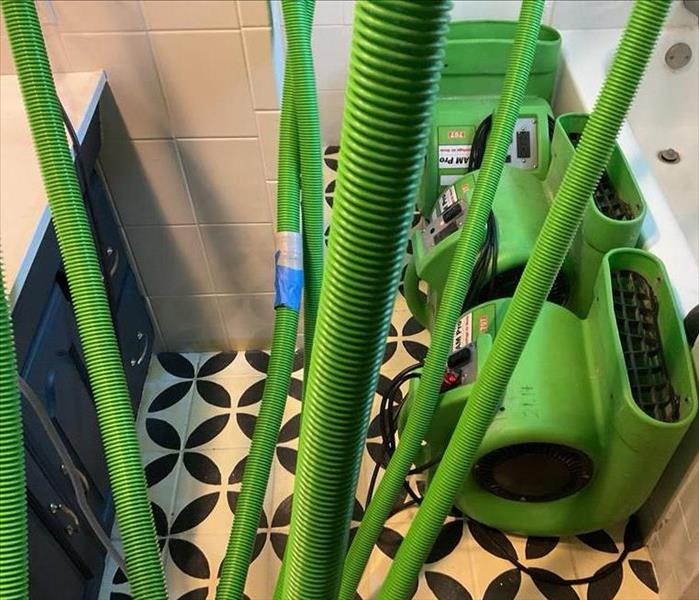 Targeted Drying in Action: SERVPRO's equipment hard at work restoring a water-damaged bathroom and preventing further damage.
Targeted Drying in Action: SERVPRO's equipment hard at work restoring a water-damaged bathroom and preventing further damage.
A slow drip might seem harmless, but over time, even the smallest leaks can lead to significant damage. What starts as a minor issue can quickly escalate into water-stained ceilings, warped floors, and even mold growth if left unchecked.
One recent job highlighted just how quickly a minor leak can spiral into a major problem. In this case, a small drip from an upstairs bathroom seeped into the bathroom below, doubling the damage. Fortunately, SERVPRO was ready to step in and restore the spaces.
Assessing the Damage
When our team arrived, we conducted a thorough assessment and located all affected areas. To ensure effective drying, we:
- Drilled small holes in the ceiling of the lower bathroom to promote airflow.
- Removed trim and drilled into the base of the walls in both bathrooms to target trapped moisture.
- Monitored progress daily to track drying and adjust our methods as needed.
For the significant moisture hidden within the upstairs bathroom’s drywall, we used the Inject-a-Dry system, a targeted solution for hard-to-reach areas.
Restoring the Spaces
Once the moisture was fully addressed, our construction team took over to restore the bathrooms to their original glory. Their work included:
- Installing a new vanity, medicine cabinet, and light fixture.
- Reattaching baseboards and adding towel bars.
- Matching every detail to the customer’s specifications to ensure satisfaction.
Why Choose SERVPRO?
From the initial assessment to the final touches, SERVPRO’s team had the tools, expertise, and commitment to handle every step of the restoration process. Whether it’s a slow drip or a sudden flood, we’re ready to restore your space and prevent further damage.
Don’t let a small leak become a big problem. Call SERVPRO today for a quick and professional solution.
Spring Flood Defense: Safeguard your Valuables
4/15/2024 (Permalink)
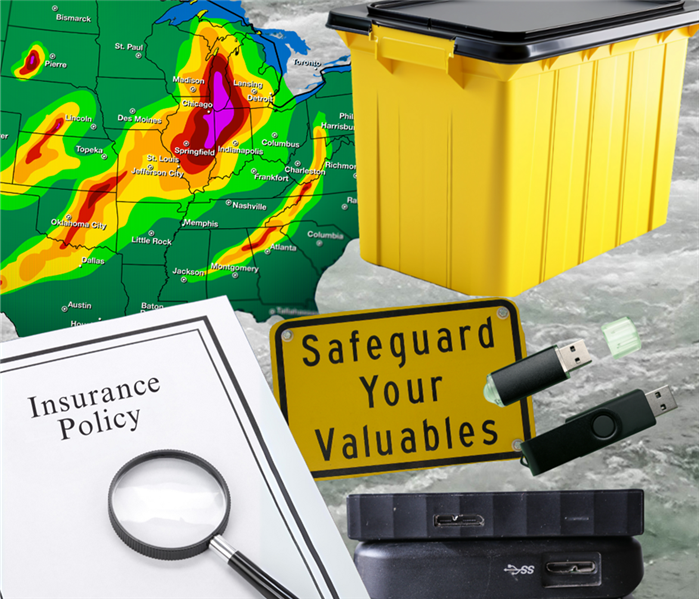 Saving precious items is invaluable.
Saving precious items is invaluable.
In a world filled with advice and warnings, staying prepared for emergencies can seem overwhelming. But when it comes to saving valuable items or even lives, the effort is worth it. Recently, my sister faced a devastating water and sewage backup in her basement, resulting in a total loss. Despite having a local SERVPRO to assist her (GO GREEN!), some items, like precious artwork and a drawing of her and her late cousin, are irreplaceable.
Another major concern was her computer. As a professional photographer with her office in the basement, thousands of photos and memories were stored on it. Why share this? So you can prepare for a similar situation.
While you might not salvage everything, materials like drywall and carpet will likely need restoration, saving precious items is invaluable and worth the effort.
Here are some tips on how to safeguard your basement during this season where flooding is even more likely.
Take stock of your basement belongings, focusing on items of sentimental or monetary value such as family heirlooms, photo albums, important documents, and electronics.
Store valuables in elevated areas, using shelves, raised platforms, or stackable containers to keep them above potential floodwaters.
Invest in waterproof containers or storage bins to shield your belongings from water damage. Ensure tight-fitting lids to create a barrier against moisture.
Preserve memories by digitizing photos, documents, and other irreplaceable items. Store digital copies on external hard drives or cloud-based platforms for added security.
Take proactive measures to minimize flood risk, such as clearing gutters and downspouts, ensuring proper drainage away from the foundation, and installing a sump pump or backflow valve.
Monitor weather forecasts and flood warnings in your area. Stay informed about potential flooding threats and have an evacuation plan ready if needed.
More Than a Busted Pipe
9/6/2022 (Permalink)
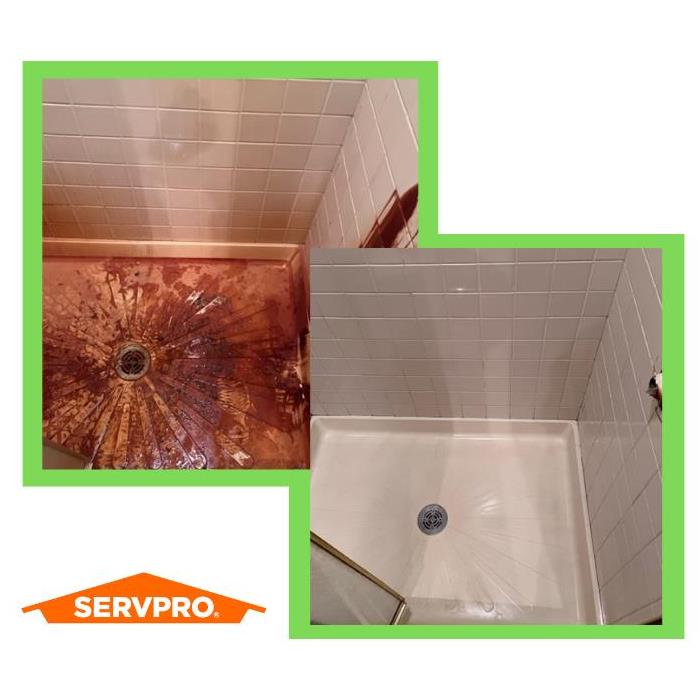 Hats off to our Cleaning Technicians on this one!
Hats off to our Cleaning Technicians on this one!
It is no secret that a busted pipe can cause a lot of damage to a home or business. Our pros worked on a job where a pipe break caused quite a bit of water and mold damage. Our team worked hard at getting this home all dried out and back to its preloss conditions.
While water damage and mold were being put at bay, there was an additional problem: our cleaning technician, Autumn, put her cleaning skills to the test to clean up.
SNEAKY PIPES
Sometimes when pipes break, this causes discolored or smelly water due to the dirt and other contaminants that can get into the water. Over time an undiscovered water pipe break will rust, giving the water a brown/red tint. This is what happened to this homeowner, and it left a significant amount of rust on their shower. No matter the cause of this rust, it was clear that there was a big mess that needed some elbow grease.
THE RESULT
This rusty shower was no match for SERVPRO of Black Hawk County. What was once a shower covered in rust, was now sparkling white!
When we say we clean it all, we mean it! A lot of times losses come with different circumstances. We are ready to tackle it all!
Call us today! 319.268.1521
So, You Think You Have Water Damage?
6/9/2022 (Permalink)
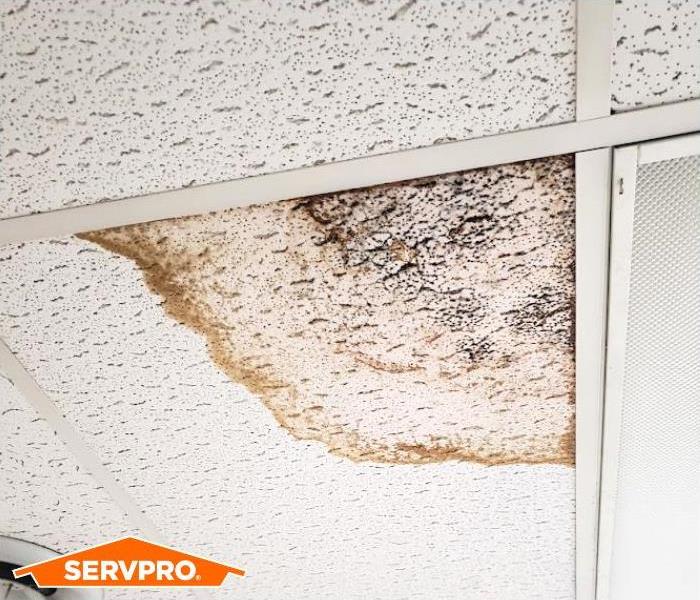 If your ceiling looks like this, your next phone call needs to be to SERVPRO of Black Hawk County!
If your ceiling looks like this, your next phone call needs to be to SERVPRO of Black Hawk County!
It's common that with water damage come signs that let you know something is not quite right. Why would you seek out this damage, you may ask? Let us tell you!
WATER DAMAGE CAN BECOME DETREMINETAL FOR A HOMEOWNER
When it comes to possible water damages, whether you can see it or not, you need to take action. Water damages can cause severe problems to your homes structure and worse yet, can cause health effects. High moisture levels can lead to bacteria growth in your home.
KNOW THE SIGNS
Now that you know the importance of why taking care of water damage properly is so crucial, lets talk about what you should look for.
First thing to look for are dark or wet spots, typically on your walls, ceilings, or floors. Many times, water will cause discoloration in certain areas. Secondly, search for any areas that seem to be cracking, flaking off, or bubbling. If you suspect there is something off, you can also listen for any running water sounds.
Using your other senses, take a whiff! If you smell musty, damp, or moldy odor, this can also be an indicator of water damage.
YOU FOUND INDACTORS OF WATER DAMAGE, NOW WHAT?
Depending on if there is current water still seeping from somewhere in your home, you may want to find your water shutoff to prevent further damage.
Once water damage has been determined, one of your first calls should be to your insurance company. Directly following call SERVPRO. Our licensed professionals will get your taken care of and ensure that everything is properly dried and no mold growth has presented itself.
SAVE $$$
Knowing the signs of water damage not only makes your more educated when it comes to maintenance in your home, but it also can save you a lot of money in the long run if you can see the signs right away by preventing further damage.
If you think you see any signs of water damage in your home or business…Call SERVPRO of Black Hawk County today! We are here to help!
Seeing is believing! Sewer Backup Catastrophe
6/1/2022 (Permalink)
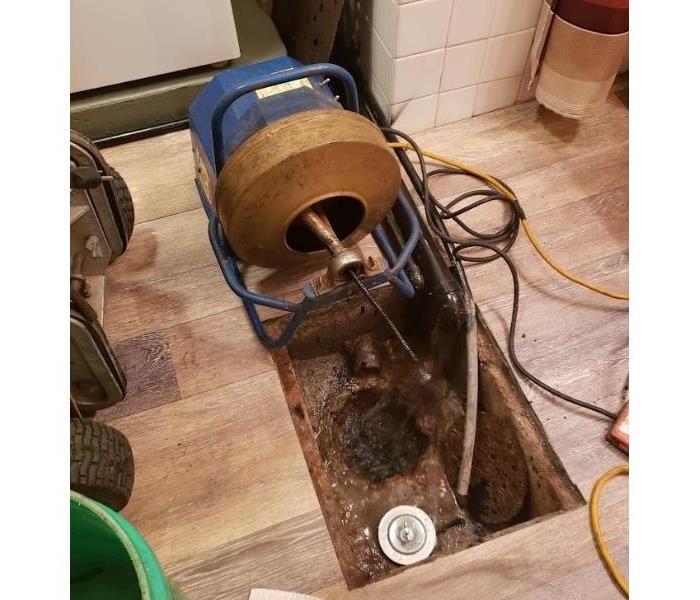 Service your drains to prevent a catastrophe!
Service your drains to prevent a catastrophe!
Touring SERVPRO work sites is very beneficial in discovering what it takes to cleanup and restore.
When I took the field trip to a job that focused on sewer backup cleaning, I never imagined the impact it would leave on me! It is often said, putting yourself into another person’s shoes-situation-can help you understand what they are going through.
At this site, SEEING WAS BELIEVING! The basement I visited looked almost exact to my own. The washer and dryer, furnace and water heater were all located near the ‘drain pit’. It is this pit where not only the water from outside tiling flows in, but where my shower, washer and the furnace drain tube empty into. It is also this drain pit where sewer backs up and enters your home when a clog develops! Weather, like excessive rain, can sometimes trigger the backup.
Running Slow?
If a drain is running slow or clogged, it will ‘show itself’ in a horrible way. Consider a few maintenance steps to put off a catastrophe. I made a call to a plumber and inquired on what I needed to do to prevent sewer backup. Snaking is the act of running an auger like cable down the drain. It will push through physical clogs that chemicals can not break up. Once you have hit the blockage, it will be loosened to flow out, and the auger is brought back out. Sometimes pieces of the clog will come with it-and often is due to hair, debris and even tree roots.
ALL the WAY to the Street!
Ask your plumber to snake your drain pipes all the way to the street. Sometimes the blockage is loosened but not mined all the way through to the city sewer line, which runs underground in the street. Snaking the large cleanout pipe will provide more peace of mind. Be sure to run or flush with water for several minutes after the snaking. A bucket of water is helpful in the main drain.
Thankful and Educated
I’m glad I got to see what could have been, before it was! If you have experienced a backup by either sewer or water, call a plumber to open your drains. Then call SERVPRO of Black Hawk County to clean up what’s left behind. 319.268.1521
Pay Attention to the Sounds in your Bathroom!
3/25/2022 (Permalink)
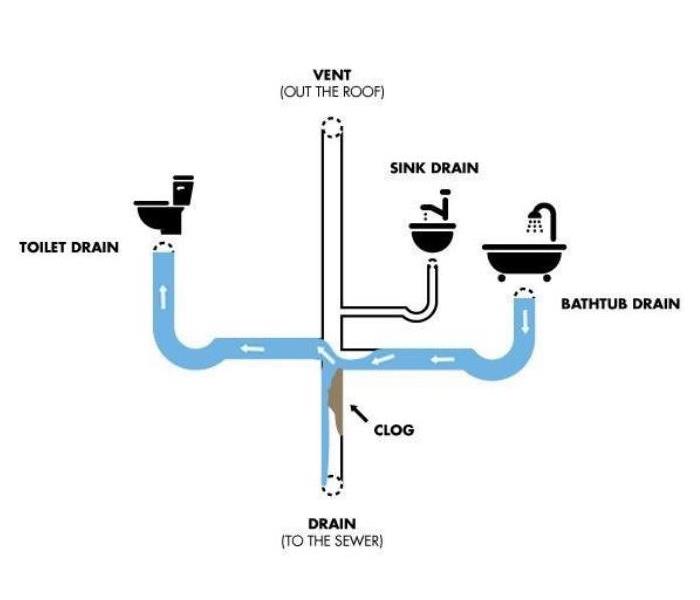 Take a look at this visual!
Take a look at this visual!
Your drain is demanding help
If you hear gurgling noises in sinks, showers, toilets, and floor drains, it is actually a yell for help! These noises signal that there is a possible blockage somewhere. Do not ignore these warning signs.
Vent, drain, and, main line…How is it all tied together?
Located on the roof and running through your home to the mainline connected to the city sewer, the vent or stack pipe plays two roles. It removes sewer gases and odors, which keeps your house from smelling. And second, it brings fresh air into your plumbing system to maintain pressure and helps water drain properly. It is the hub of the entire plumbing system.
In this image, the toilet, sink, and bathtub all drain to 1 mainline and all vent through 1 main vent.
If there is a clog somewhere in this line (drain pipe or vent pipe), the air is either pushed out or sucked into one fixture (like the toilet), when another is used (like the shower).
The main sewer drain line, most likely buried and running through your lawn, carries all the wastes to the city sewer line. It can also plug with tree roots and household debris and remains.
While the gurgling noises may seem like a nuisance, they can lead to larger issues, like damaged pipes and possibly sewer backup into your home.
Understanding the draining concept
Try this: Turn a plastic soda bottle filled with water upside down and open the cap. The water will pour out in waves as air is pushing its way past the flowing water. The gurgling sound occurs when this repetitive act of flowing water and air move in and out of the bottle.
Call a professional plumber to assess the situation and possibly clear the blockage.
Don’t wait too long, otherwise, our green SERVPRO trucks will be needed to clean up the yuck backup!
HERE TO HELP.
What to Know About Melting Snow!
2/28/2022 (Permalink)
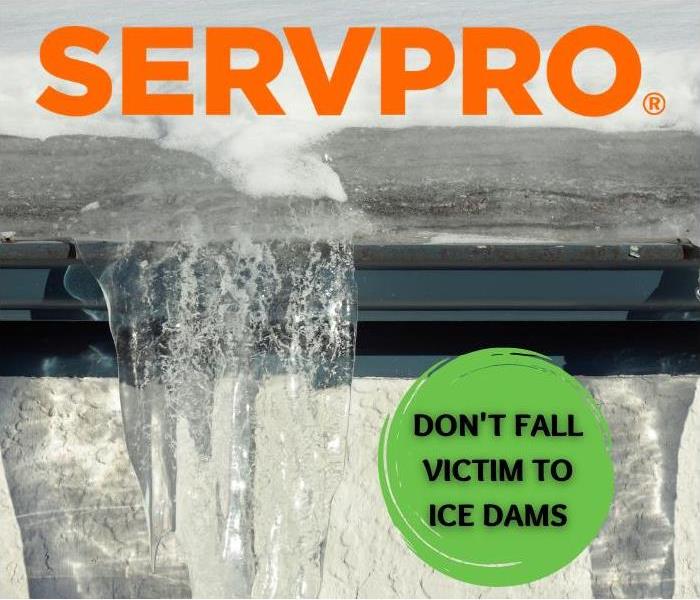 Be smarter than the snow!
Be smarter than the snow!
It’s that time of the year when flower buds, sunshine, and chirping birds are at the forefront of our minds. There is a peaceful feeling that comes with the winter months melting before our eyes. While we know how exciting this change in season can be, there are a few things you should be aware of!
ICE DAMS
During the cold season, snow and ice will often form around the gutters and lower portion of your roof. When the heat from your roof melts this snow, it begins to pool and gather in your getters. This water then freezes and will create icicles or ice dams.
The problem with this is that when it begins to melt during the blooming of spring when the water has nowhere to go, it will begin to seep in through your roof.
THE TRICKLE EFFECT
When this happens, there is one other big issue that can occur, the big M word. Mold.
Mold can be a serious health hazard, so you want to avoid ice dams and water damage at any cost.
HOW TO AVOID ICE DAMS
Here are three tips that can help you prevent damage from an ice dam
- Ventilation under the roof deck
- keeps colder outside air moving through the attic and prevents it from warming above the freezing point so it can melt snow on the roof.
- Insulation in the ceiling
- prevents warmer air from rising up into the attic space to melt snow on the roof.
- Blocking any heat sources
- Try to prevent any heat sources from sending warm air up into the attic.
BE IN THE KNOW
Now that you are aware of these pesky little dams, it will be a lot easier to be prepared and prevent a disaster.
Ice dams come in many severities, some may way up to hundreds of pounds, which in turn can compromise your home’s structure. Size aside, when these phenomena melt, they can flow down causing serious damage to your roof, gutters, paint, insulation and interior drywall, etc.
If you think that your home or business has been compromised due to an Ice dam or other water damage, call SERVPRO of Black Hawk County!
319.268.1521
We are here to help!
What's the 'Sitch' on Wet Checks
2/7/2022 (Permalink)
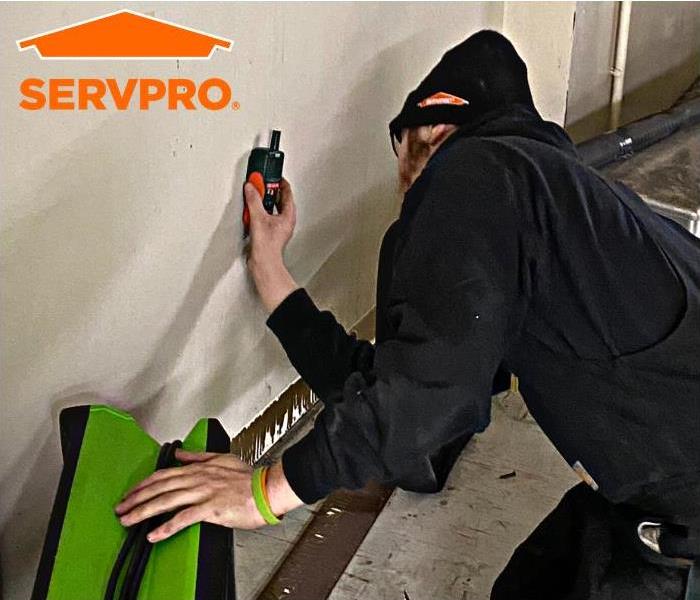 One of our technicians doing a wet check for a commercial building.
One of our technicians doing a wet check for a commercial building.
In the world of restoration, making sure things are completely dry after a water mess is important to avoid mold or other structural issues. The magic of how we gauge this is done through wet checks. Today we want to give you an inside look into how we do wet checks, so if you ever find yourself in deep water in your home or business, you might have a better understanding of the restoration process.
WHAT IS A WET CHECK?
A wet check is just what it sounds like. When our techs go into a water loss, they are checking to see how wet the affected materials are. The job is not done until everything has been properly dried out, and our team is very thorough in this process.
WHEN DO WE DO THEM?
Typically, wet checks are started on the 2nd day of the job. The first day is reserved for the initial mitigation process and setting of equipment. After the drying process begins, it usually takes about 2-3 days for materials to begin to show any signs of progress.
HOW ARE THEY PERFORMED?
Our techs use moisture meters to detect moisture. The probe that they use for the affected material, depends on the type of material they are drying out. For wood, they will use the wood probe, for moisture in carpet they use a special carpet probe. As long as they are seeing improvements in the material, they continue to wet check until it is dry.
HOW DO WE KNOW WHEN IT’S DONE?
Here at SERVPRO, we never want to leave behind any hidden water, so we have a “dry standard” by checking an unaffected material. If water was 6 inches up the wall, we get a max reading by putting the meter 6 inches up the wall. Once we have that dry standard, we continue to check the materials until they have reached that “standard” to ensure everything has been properly dried.
THANK YOU TO OUR TEAM!
We are so fortunate to have a team that provides such great attention to detail, and gets the job done properly! When you are in need of water cleanup, call SERPVRO of Black Hawk County, we will take care of you, and make it "Like it never even happened."
Discover the Source and Turn Off the Stress of a Mess!
1/11/2022 (Permalink)
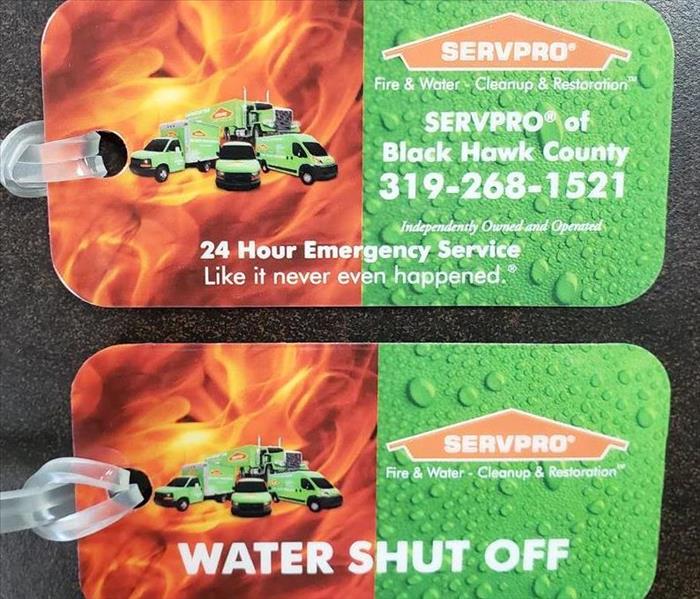 Be prepared by placing these shut off tags on water sources in your home and business. Lessen stress by knowing where shut off valves are located.
Be prepared by placing these shut off tags on water sources in your home and business. Lessen stress by knowing where shut off valves are located.
Determining the location of water shut-offs in your home and business can turn off the stress of a mess created by leaking, or worse, overflowing and spraying water!
Homes and business buildings have MAIN WATER VALVES that supply ALL the water, which is located outside of your home, usually in the front yard and at the meter entering your home. This is the water source coming from your municipal water company located in the street area. Sometimes this valve will need to be shut off completely to the entire home for a repair, but a plumber or the water company usually assists with that.
If you have discovered water in your home, and it is not from an outside source like rain, first look for an individual or isolation water valve near the area or appliance. Look for exposed plumbing in this area.
Toilet: behind or under the toilet base. Turn the handle clockwise until it stops, being careful not to force it.
Sink: in the cabinet below, there are 2 sets of flexible tubes, one for each hot and cold water. Turn the valves on these handles, again not to force, clockwise to shut them off. Sometimes a bathroom sink will have levers instead of valve handles.
Bathtub/shower: The hot and cold-water valves are most often tucked in an access panel and can be hard to locate and get to. Finding the main water shutoff in* your home is best bet for these issues.
Refrigerator: turn off the valve on the supply tube running to the refrigerator. Like the shower, this can be located in a walled off panel, sometimes located in your basement.
Clothes washer: some houses have these clearly exposed behind and above the washer. If not, pull the washer out to find. Turn off both hot and cold valves.
Water heater: The cold-water inlet valve is located on the heater and generally is a ball shutoff valve, looking different than the other valves we have described.
*The main water shutoff in your home: located usually in the basement/utility room as part of the water meter. A facet handle shaped valve is common on these fixtures. Otherwise, it will be part of the meter on the outside of the home and be a knife-style or lever handle.
We encourage you to take 30 minutes and discover where the different on/off valves are located in your home. These common areas are the source of water issues SERVPRO of Black Hawk County cleans up after issues occur. Knowing where and which valves control the water can help you be prepared! Turn off the stress of a mess by shutting down the source of water. Always seek professional help from an accredited plumber, if you are unsure. There are lots of circumstances we can not foresee.
If you need help finding water shut offs in your home, schedule a time for SERVPRO to visit and locate with you. Call SERVPRO 319.268.1521
Vital Substance or Vicious Villain?
10/12/2021 (Permalink)
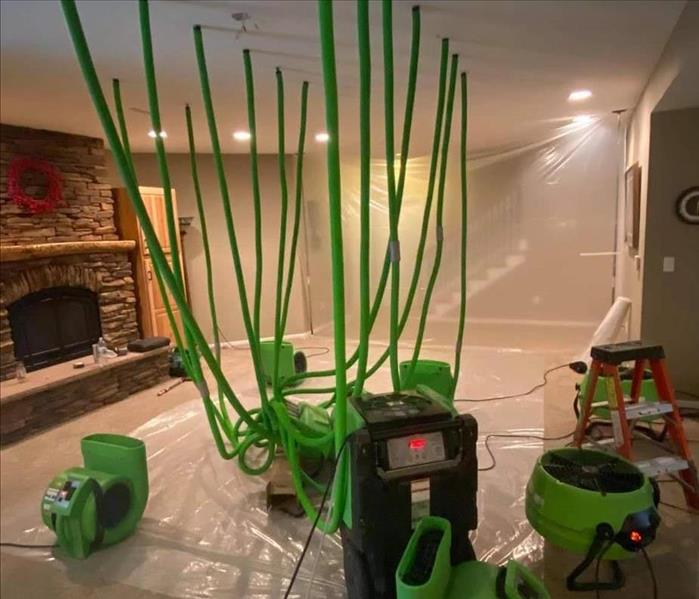 Injecta-dry unit hooked up to multiple tubes that are helping dry out the ceiling!
Injecta-dry unit hooked up to multiple tubes that are helping dry out the ceiling!
Water… It’s a vital substance that all forms of life need in order to survive. Of course, we know that despite its great attributes, water can also be the reason for immense stress and mess (aka a villain). This job is the perfect example of how water can creep its way into your life, putting an extra think on your plate. Thankfully we have amazing equipment that can help us keep your home as intact as possible when water has a mind of its own. This equipment here is an injecta-dry unit. Our team set this up by drilling holes and putting these tubes up into the ceiling which then pushes air into the ceiling cavity and in turn, produces quicker drying time for the drywall as well as the subfloor from underneath. In this particular job, they were able to utilize multiple hoses in different areas all off of one air mover! The team provides special care and attention to detail when doing this. They are able to dry out the space rather than just coming in and saying that the ceiling needs to be torn out, which is a huge relief for our customers to hear!
If you find yourself in deep water, give us a call at (319) 268-1521 so we can make it "Like it never even happened."
The Craft of Water Restoration
9/13/2021 (Permalink)
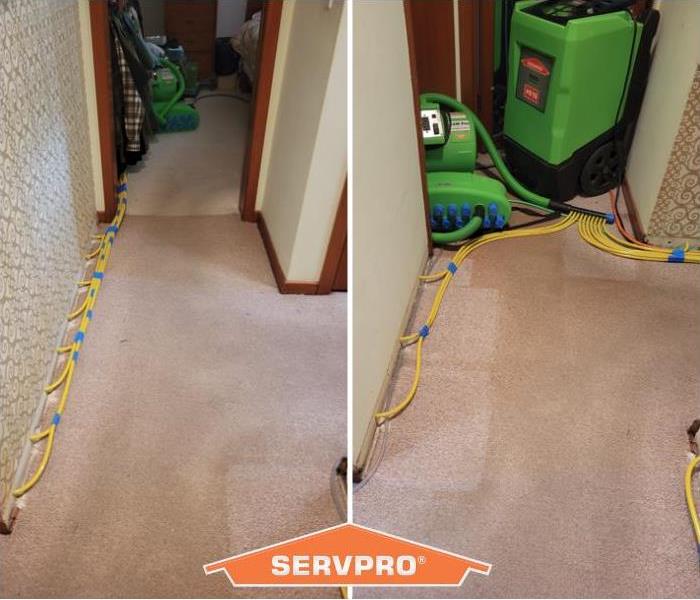 Our Injecta-dry at work alongside Mike's careful construction!
Our Injecta-dry at work alongside Mike's careful construction!
Our technicians are highly trained and certified when it comes to cleaning up a water mess. What you can't always teach is the heart to go above and beyond as our techs do!
The Mess
When a faulty toilet tank float creates a waterfall in your bathroom and a river in your hallway making the home trail unpassable; you must carefully place every hose for drying out purposes of the Injecta-Dry, making a clear and safe pathway!
The Craftmanship
Our production technician, Mike showed his care & concern by being very proficient in his design. Removing baseboard and directing heat to dry out walls is crucial in making it “Like it never even happened."
We are so lucky to have a team that puts their heart into the job every day!
Is Your Laundry Room Wet? Watch out For Mold!
6/24/2021 (Permalink)
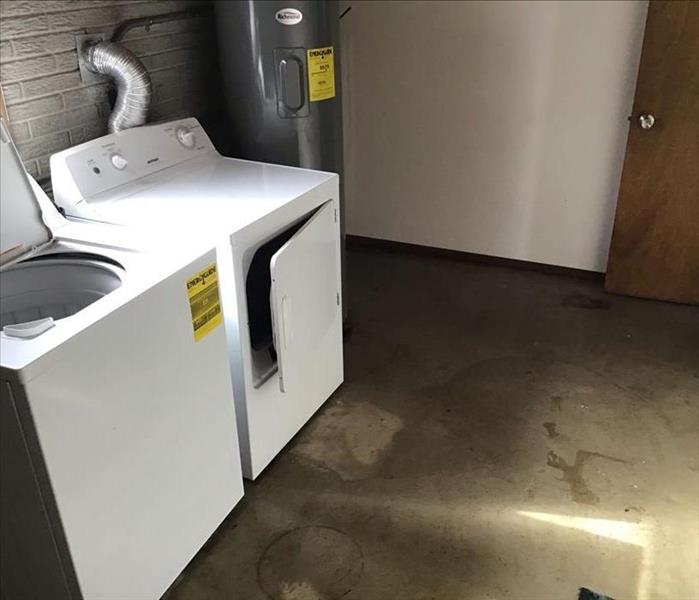 Lower level laundry room, pre mitigation
Lower level laundry room, pre mitigation
Do you have a room specifically for your washer and dryer? I do but it’s in my unfinished basement. The water hose from the washer machine is directed and near the floor drain. The room tends to feel wet and humid. Some ways we have been able to combat that is with a dehumidifier but there’s a few more suggestion from personal experience I would like to share.
- Do not leave clothes on the floor if you have water issues. Damp clothes will start to smell mildewy and mold can begin to grow on them. Instead, leave them on a plastic hamper away from water.
- When you wash clothes, put a timer on your phone to remind you to move them to the dryer. If you leave clothes in the washer for too long, it will also start to smell like mildew. You will have to wash your clothes again.
- When you are done washing your clothes, leave the washer door open to air out and dry.
- If your washer or dryer has rubber around the door, occasionally spray microbial cleaner on it and wipe it down.
- If mold starts growing on your clothes, do not just throw them in the washer. Check out this link for cleaning recommendation CLEAN MOLD FROM FABRIC & CLOTHES.
- Double-check your dehumidifier to see if it’s working properly. Some dehumidifiers have a pump to dispose of the water gradually or a bucket that collects water. Make sure the hose is placed towards a drain or empty your bucket.
- If you have surface mold in a small area, use a mold-specific solution to kill the mold, scrub the pores, and wipe clean.
- If you are constantly dealing with water issues such as water seepage through the foundation or water leaks from your washer, fix the issue! The longer you wait, the worse the water damage may become.
- Add a water detector near the washer and floor drain in case of flooding.
If you suspect mold on a large scale, give SERVPRO of Black Hawk County a call.
Making sure your best vacation doesn’t turn into your worst vacation when returning home
6/4/2021 (Permalink)
 Enjoy your vacation and stay safe!
Enjoy your vacation and stay safe!
Where did the masks go??? As we continue to gain confidence in our health, more and more people are venturing outdoors and traveling. Perhaps you have been thinking of a nice escape as well? That’s good news! We all deserve to be refreshed once in a while. As you get ready to pack your bags and go on vacation this summer, SERVPRO wants to share a few tips to protect your home.
- Unplug electrical items to prevent an electrical fire especially during a storm.
- Shut off your main water valve to avoid water damage.
- Have a family or friend check your home daily.
- Properly close and lock all doors and windows to protect your home from animals and thieves.
- Turn off your AC unit to save energy.
- Remove any items that might turn bad from the refrigerator.
- Remove trash from your home to return to a fresh-smelling home.
COOL DOWN WITH SOME COOLER TIPS
Now that you have done the responsible things to protect your home. Here are a few articles on vacation tips regarding coolers.
https://www.popularmechanics.com/adventure/outdoor-gear/a19638152/how-to-pack-cooler/
Enjoy!!!
Where’s the pool of water in your kitchen coming from?
3/2/2021 (Permalink)
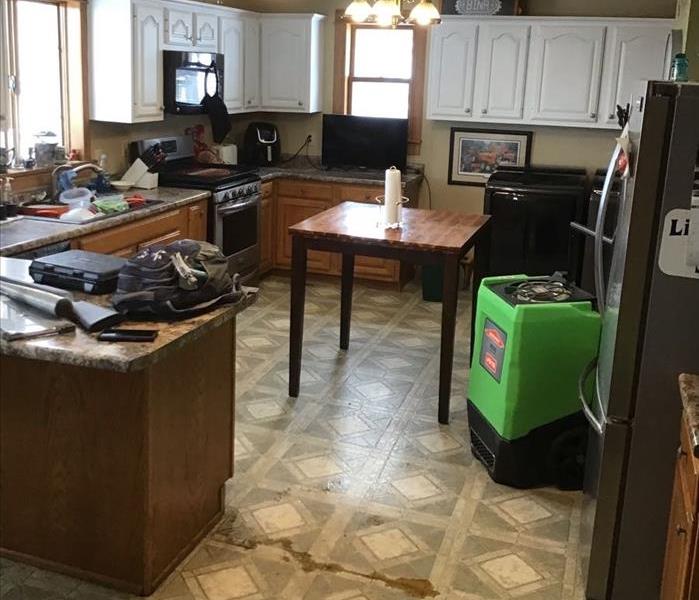 Find the source of the water to protect from extreme water damage.
Find the source of the water to protect from extreme water damage.
Are you constantly dropping paper towels on the floor and with your foot dragging it across a pool of water that just appeared out of nowhere? There’s not even a streak of water to determine which direction it came from. Is it coming from underneath the floor? Have you investigated or allowed it to be apart of your daily routine? Well, continual water on your floors may be a bigger problem than you think. There’s a water leak in your home.
Water Damage in your Kitchen
Not only can a pool of water be hazardous to your safety but it can damage the walls and flooring of your kitchen. Water that has not been dried properly or that continues to show up may promote mold or mildew growth and weaken building material such as drywall or flooring’s adhesive. SERVPRO of Black Hawk County suggests that you DO NOT IGNORE, FIND THE SOURCE! This will protect your home and pocket especially if you are considering filing an insurance claim on the water damage. Some insurance companies may not cover the claim if there’s proof that the issue was neglected over an extended period of time.
POSSIBLE SOURCES OF WATER LEAKS
Here are a few areas to investigate for signs of water leaks…
- Under the sink- Quick tip: Place a plastic tub under the main sink’s plumbing lines. It’s the little leak that wreaks havoc!
- Behind the refrigerator by the water line
- Underneath the refrigerator near a bottom freezer.
- Around the dishwasher.
- In the basement, underneath the kitchen.
Signs of water leaks can look like water stains, mold growth, or rotted wood. As Fix A Leak Week approaches (March 15th- 21st), the US Environmental Protection Agency (EPA) has great resources on how to DETECT AND CHASE DOWN LEAKS. <- Click the link for a helpful checklist!
A great tip from EPA.gov is to read your water meter during a period when no water is being used. If the meter reading changes there is definitely a leak somewhere in your home. If you still can not find the source, you may need to seek assistance from a professional such as a plumber.
Have water damage in your kitchen? Call SERVPRO!
SERVPRO of Black Hawk County is available for Inspection and Water Damage Assessment to determine areas of concern with moisture readers and thermal infrared cameras. While we do not repair pipes, we can help clean up after water leaks, floods, sewer backup, and pipe breaks. Call us at 319-268-1521.
Protecting your home against SNOW
2/9/2021 (Permalink)
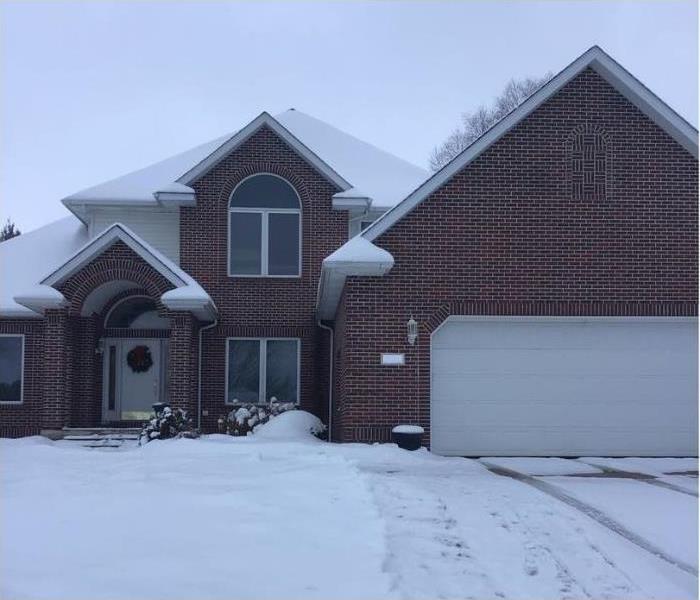 Do not use a ladder to shovel your roof.
Do not use a ladder to shovel your roof.
Now that the groundhog indicated a LONG WINTER, we thought it would be a fantastic idea to go over some snow and ice removal tips that may help you avoid water or storm damage to your property. Heavy snowfall and even ice can start water damage to your home.
5 Tips for snow and ice removal on your home
- Shovel snow away from your foundation – Driveways, sidewalks, and entrances are all important areas to shovel but another area that should be considered are those areas nearest to the foundation of the home. A pileup near the structure is not a good idea especially once it starts melting. Flooding can occur and water may seep into your home and inside your basement.
- Do not shovel your flat roof – Some people could think that shoveling their roof might be a good idea especially when the snow footage is in eye view. Some concerns are wet snow and the weight collapsing a roof but your roof should be able to withhold the weight. Shoveling your roof on your own is putting yourself at risk of injury, plus, you might actually cause damage to the roof instead. We recommend calling a professional to remove the snow
- Use roof rakes for sloped roofs on detached garage or sheds to remove SOME snow – This is a safer way to remove a few inches of snow because it doesn’t require you to stand on a ladder. This is why we recommend it on small structures such as a garage or shed. When using the roof rake make sure you are not scraping the snow off the shingles as you may damage it. Less snow on the roof can help avoid ice dams.
- Do not chip off ice dams with a hammer or ice pick – If you have ice dams, leave them alone unless you are certain that the ice dams are resulting in water leakage in the attic or ceilings. If the ice dams are causing water damage, you might be able to freeze the leak by aiming a boxed fan at the leakage inside the attic. For more info on how to get rid of ice-dams CLICK HERE.
- Inspect the roof and ceiling before, during, and after winter – Your roof may be pretty healthy now but over time, your roof will need maintenance. During this time, it will be difficult for a roof inspection but if you see some areas of concern such as a collection of ice dams in certain areas, take a picture and save it to reference later during a future roof inspection.
Wet insulation can cause Mold!
If you suspect wet insulation in your attic or water damage, give us a call! We can help remediate the issue and restore your home. Call us at (319) 268-1521.
Home Maintenance List
10/13/2020 (Permalink)
 Home Maintenance keeps your home healthy!
Home Maintenance keeps your home healthy!
With our changing seasons, we usually all remember to change the heating and cooling furnace filter but it's the upkeep of other appliances and essential working parts of our home that we need a reminder.
- DISHWASHER FILTER - Wipe off with a paper towel, then rinse with hot water till the water runs quickly through the screen. Use mild soap if needed.
- GARBAGE DISPOSAL - Turn off the power. To remove sludge, fill the sink with ice cubes then pour in 1/2 cup of coarse salt. Let the ice sit for about 30 minutes, then turn on the garbage disposal and the faucet and leave both on until all the ice and salt are gone. Use a scrub brush to clean the drain and baffle.
- BATHROOM EXHAUST FAN - Turn the fan off. Remove the plastic exterior grille. Wipe or vacuum with a bristle brush to thoroughly remove dust. Carefully vacuum the fan housing and around the motor.
- DRYER LINT SCREEN - Remove lint, then rinse with hot water till the screen runs clear and quickly through. Use mild soap if needed. The flexible dryer duct should also be cleaned out to make sure the lint is not clogged. Make sure the outside vent is cleared.
- FLOOR DRAIN - Remove debris and sand while wearing disposable gloves. Annually, have a floor cleaning expert to ‘snake’ or clear buildup from hair, laundry soap & fabric lent, and especially tree roots that block flow.
- DEHUMIDIFIER FILTER - Wipe off with a paper towel, then rinse with hot water till water runs quickly through the screen.
- SUMP PUMP - Test the flotation device by pouring enough water into the sump basin to trigger the pump, make sure the float moves freely and the sump pump activates when the water gets high enough. Let the pump remove most of the water and make sure it shuts off when the water is only a few inches deep. Repeat this test one more time. Make sure the intake screen or discharge pipe is not clogged. Purchase a battery-operated pump or have a generator to use if the pump were to stop due to power failure.
- AC UNIT - Turn off. Use a leafblower to remove large debris. Spray water to clean off loose debris. Spray outside unit with coil cleaner and wait 15 minutes. Rinse the cleaner off with water.
***Every appliance model is different so make sure to research your item for the location and best maintenance practices.
DOWNLOAD OUR MAINTENANCE LIST
As always, SERVPRO of Black Hawk County is here to help.
Average Cost of Water Damage in 2020
9/14/2020 (Permalink)
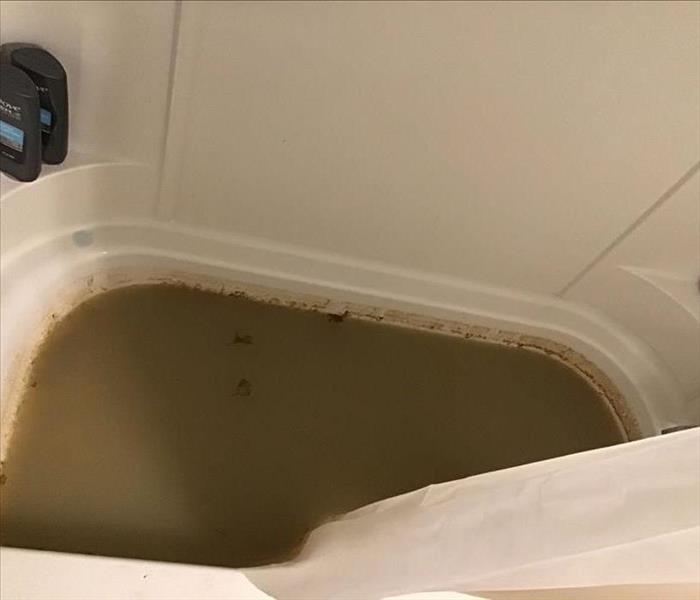 Sewer damage can increase a water damage estimate.
Sewer damage can increase a water damage estimate.
Many of our potential customers call us asking questions very similar to the following; “How much would it cost to clean my basement from water damage?” We understand the importance of this question especially as individuals who also ask the same type of question when we need services done for us or to us. At times, we do find ourselves shy in giving a definitive answer because there are so many factors in pricing for water damage. From the type of water to the number of affected contents, there’s a lot that can happen to your home when unfavored water is present. Still, we want to give you an idea of how much it could cost. According to Home Advisor, the average cost of water damage is about $3000.
Potential reasons why pricing may increase.
- Structural damage – Demolition of affected drywall, ceiling, removal of trimmings, removal of carpet, trash disposal, etc.
- Amount of Affected Contents – An unfinished basement could cost less than a finished basement because of the lack of contents.
- Type of Water – Sewer water aka “black water” is hazardous. Will require cleaning, disinfecting, and possible structural restoration.
- Amount of Water- Extraction time and drying time may take longer due to the amount of water.
- Square footage- A small affected room could cost less than a whole affected floor.
- Mold – Moisture is a breeding ground for mold. The longer you wait to dry an area, the higher risk your home has of getting mold. Mold remediation will increase the price.
The Benefit of Insurance is Peace of Mind.
Did you know that Insurance can help cover the cost of water damage in your home or business? We want to encourage you to find out more information about your insurance coverage and if your provider covers water damage, sewer damage, storm damage, or mold remediation. You might want to consider paying a little extra now on premiums so that later, you could pay less.
We can inspect your water damage! Please give us a call at (319) 268-1521.
References:
https://www.homeadvisor.com/cost/disaster-recovery/repair-water-damage/
https://www.fixr.com/costs/water-damage-restoration
First Notice of a Water Loss – The Phone Call
6/23/2020 (Permalink)
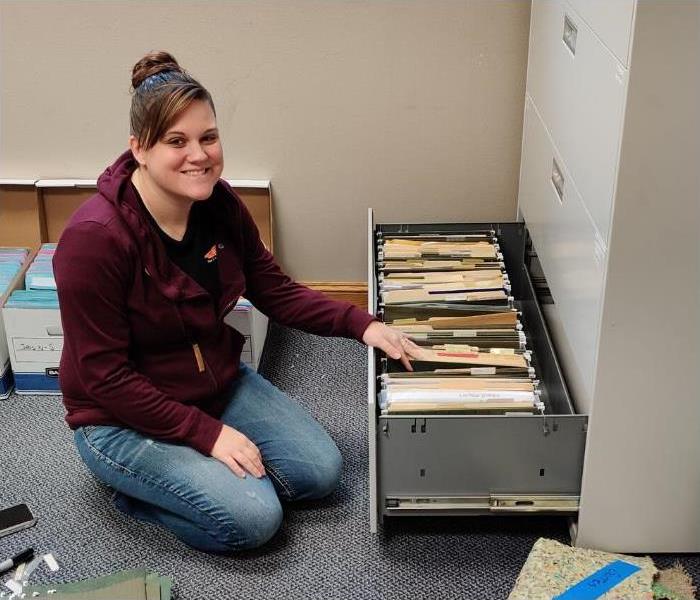 Michelle Miller - Job Coordinator by day, Rock star EVERY DAY!
Michelle Miller - Job Coordinator by day, Rock star EVERY DAY!
On Monday (June 22, 2020), we received over 50+ calls at our office concerning some type of water problem in homes. We refer to these problems as a ‘water loss’. The majority of calls focused on issues with basement floor drains or the sump pump. This is not our usual Monday. The call that we receive is a lead on a job and referred to as the First Notice of Loss, shortened to FNOL. On this call, our team is asking questions and collecting all the information they need in order to respond to the request for help as quickly and as efficiently as they can. So, here’s what to expect when you call us.
**Ring
SERVPRO, how can we assist?
During office hours (Monday – Friday from 8am-5pm), our phone calls come straight to our local offices where our job coordinator, Michelle Miller, answers it. Many might see her and think she’s “only” a receptionist but she does more than answering the phone. She is vital to our operation. We all seek and appreciate amazing customer service and that is what Michelle does every day as she answers calls from worried and sometimes frantic people. Disasters are scary and we understand that. At SERVPRO of Black Hawk County, we give you peace of mind from the very beginning with our empathy, honesty, and professionalism.
FAQs
There are 3 important details that we collect during the FNOL.
- Caller Details – Name, Phone, Is the Caller the Customer? Etc.
- Customer Details – Name, Phone, Email, Loss Address, City, etc.
- Loss Details – Type of Loss, Date it occurred, Cause of Loss, Finished or Unfinished Basement, Residential or Commercial, Type of Flooring, Is there standing water? Etc.
Who is your Insurance Provider and Agent?
Home Insurance policies may be able to cover water loss expenses so we work closely with our local insurance agents and adjusters. We ask the customer who their insurance provider and agent are for two reasons…First, to remind the customer that their insurance can possibly help them. Secondly, to determine their coverage and if they will be turning the damage in as a claim.
Our desire is to be “Faster to Any Size Disaster” 100% of the time, but when heavy call volume occurs, it won’t ever seem fast enough! We respond and follow up to every call. We know first-hand how crucial timing is with a water issue and cleanup is needed. A waiting list is often started, and as hard as it is to ask, we encourage people to continue contacting other restoration and cleanup companies that may be able to assist sooner. SERVPRO cares about you enough to make this recommendation! What’s most important is that you are helped, even if it’s not through us. We’d rather gain a friend and direct you to another than to lose you over a promise we can’t keep.
Water Damage? Give us a call at (319) 268-1521. We’re Here to Help, all ways.
Gear to stop the fear of Water Damage
6/16/2020 (Permalink)
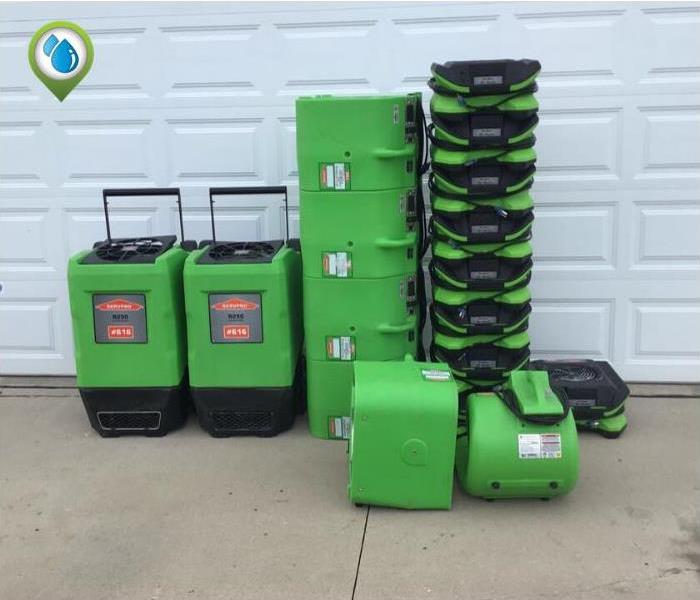 Water Cleanup is more than water extraction. The Drying process is key.
Water Cleanup is more than water extraction. The Drying process is key.
As a home or business owner, the fear and anxiety of the possibility of water damage are real. Mostly because we have seen or heard the outcome and headache it can be. SERVPRO of Black Hawk County has answered many calls of water loss and we are grateful for the opportunity to help. We are qualified and equipped to clean up the mess as fast we can to prevent further damage and restore you to a home and business that functions. After we extract water, there are a few pieces of equipment that we utilize to make a water loss like it never even happened.
Sensing more than the eye can see…
We have two different technologies that we can use to detect moisture in hidden places. One of the moisture readers is a 2-pin Moisture Sensor that has 2 pins that can penetrate through wood, carpet, carpet padding, and drywall to find an accurate reading of the wetness of the area. This can help us determine how far the water has spread. The other technology to detect water is an Infrared Moisture Reader that can detect moisture through a thermal reading. Sometimes water damage is not as obvious but there are suspicions because of the humidity in a room, or the smell of mildew. An example of when we had to use this is after we found some mold in a basement. The homeowner’s basement flooded and decided to try to clean it up on their own. They extracted the water and set up fans everywhere. The floors and walls all felt dry. After a few weeks, we received the call for mold cleanup. After using the Thermal Moisture Reader, we found their downstairs cabinets, the walls behind it, the closets, and some parts of the ceiling were still wet!
Humid, sticky & wet… we’ll use a Dehumidifier.
Another equipment that we use is a Dehumidifier or as we (restoration specialists) like to call it, Dehus (pronounced Dee-hue). A dehumidifier helps reduce water in the air and maintain the level of humidity in the air. We set this up every time we work on a water loss to prevent the growth of mold. You would be surprised by all the water it collects from the air.
Dry. Dry. Dry.
We use various types of air movers to ensure the home or business is completely dry. Air movers are often compared with fans but unlike fans, air movers can be much more precise and often have a higher air velocity. We place several air movers around the area. If you walk into a water loss job, you can find several air movers on an axis frame directed up towards the wall, down toward the flooring, low central air movers alongside the walls, and air movers that direct airflow directly above the flooring. The placement of the air movers is always intentional. Our production manager speaks to our customers about the importance of the placement of the equipment and not to turn any of it off.
If you decide to clean up water damage yourself, we would love to be a resource to you. You can give us a call for any questions or even call us over to inspect the water loss and help evaluate the scope of the damage.
Call us at SERVPRO of Black Hawk County at 319-268-1521
Snow is melting - Be careful of water in your home.
3/4/2020 (Permalink)
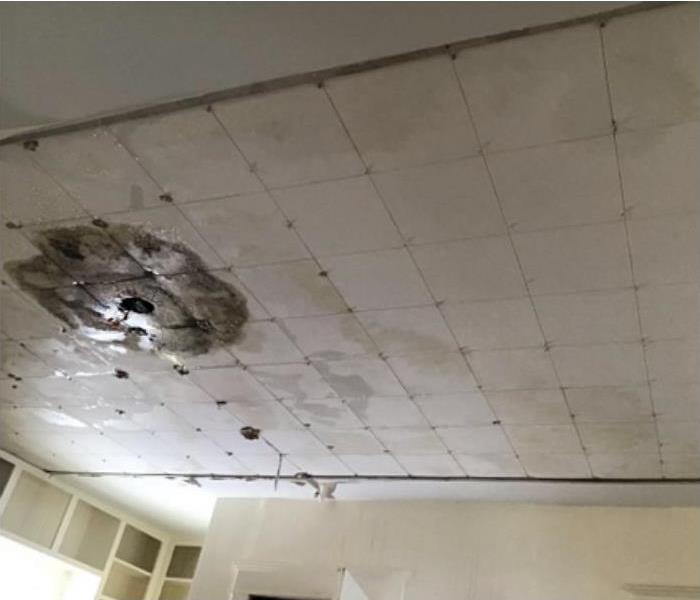 The marks on your ceiling can indicate severe water damage.
The marks on your ceiling can indicate severe water damage.
The forecast for the next two weeks looks very promising! We are edging our way right out of the 30-degree weather into the 40s, 50s and even the 60s. I’m feeling warm just thinking about it. You can kiss your snowman goodbye… for now.
Runoff Frosty!
This warmer weather does sound nice but we still need to keep in mind that snow melting, aside from the wetness and muddiness, can be a risk of water damage or flooding in your home. We want to encourage you to be observant of every area in your house especially the ceilings and the basement walls. Water can seep into your home through cracks in the roof, windowsills, and foundation.
Inspect your home
- Yellow or gray discoloration on your ceiling can be water markings. Don’t ignore them. You can lessen the damage by hiring a professional to clean your roof from snow and to check the health of your roof.
- It would be a good idea to have a restoration company check the moisture level in areas of concern. They can dry any moisture with special equipment if necessary and cut out or remove any affected porous surface that can promote mold growth.
- If you have piled snow that is near the exterior of your home, we suggest you shovel it away from your home before it melts. This can protect your home.
- Check your basement. Do not be comfortable with a wet basement. If you notice the walls, and flooring are wet, call a professional to inspect your foundation. Take care of your home! Flooring such as carpet and linoleum that has been affected by flooding might need to be replaced as well as the trim and molding.
SNOW/WATER DAMAGE IN YOUR HOME?
If water is seeping and creeping into your home, Take action! The sooner you can get help, the less damage it will create. We can help you! We are the leading water restoration company in Northeast Iowa.
Call us at 319.268.1521.
Until help arrives, read WATER DAMAGE EMERGENCY TIPS.
Water Damage, More than the eye can see.
2/10/2020 (Permalink)
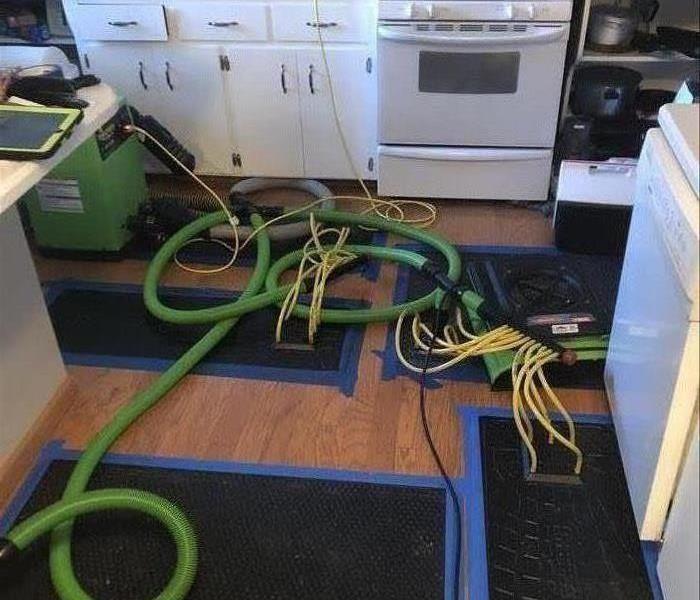 Our equipment is extracting water from the hardwood floors in the kitchen.
Our equipment is extracting water from the hardwood floors in the kitchen.
Water doesn’t stay in one place.
How do we end up working in a basement when the cause of loss is in the kitchen? Water. Water spreads because of its adhering properties and seeps into every crevice, crack, or dent it possibly can. We received a call about a kitchen sink that malfunctioned causing a flood. The water seeped through the flooring and in no time, the finished basement was unrecognizable. The paint was peeling, the ceiling tiles were stained as well as sinking, some tiles even fell off the ceiling, and everything inside was getting wet. It’s as if it was raining inside their basement.
Do you know where your water shut-off is?
Unfortunately, this family was not present when the situation developed. They returned home to a bad situation. They had the sense to turn off the water shut off valve in the basement and that’s when they noticed further damage. Shutting off your main water valve will definitely help reduce the damage so please take some time to locate yours.
Water Damage? Give SERVPRO a call!
That day, Michelle our job coordinator received their frantic phone call. She immediately worked fast to get in contact with a project manager. The project manager and a team of technicians went to the home and began water extraction, removal of the paneling in the basement, removal of cabinetry, and setting up drying equipment on the main floor and basement. The kitchen, basement, and multiple rooms on the main floor were affected by the broken kitchen sink. Before we arrived at the Waterloo home, some mold growth had already occurred in some of the drywalls and the cemented landing of their basement stairs so it was important to work fast and diligent. We cleaned and mitigated the growth.
We are here to help!
No matter the size of the disaster, we have a team certified to help in cleaning and restoration. If you suspect your sink or refrigerator is leaking, please get it looked at by a plumber or appliance repairman.
5 Tips to Winterize your Home.
11/5/2019 (Permalink)
 These tips will help avoid water damage and fire damage during the winter.
These tips will help avoid water damage and fire damage during the winter.
Let’s get ready to WINTEEER!!
It’s time to wrestle Iowa’s winter to the ground with a ton of jackets, gloves, beanies, boots, scarves, and wool thick socks. With all the layers of clothes that you and I will be wearing, there’s no way “Stone Cold Frost Bite” is going to beat us, but what about our homes? Let’s talk about how you can WINTERIZE your home to avoid water or fire damage. (Ok, I’ll stop it with the wrestling analogy.)
You can avoid Frozen Pipes or Chimney caught on Fire with these 5 Tips.
- Remove the hose from outdoor spigots and stow away for winter.
- Clean out your gutters and downspouts before winter.
- Apply caulk or weather stripping to windows that may have gaps.
- Replace the filter in your furnace.
- Check the health and cleanliness of your fireplace before igniting it for the first fire this season.
We hope this will help keep your home healthy from the cold weather. We also want to remind you that it’s a good idea to make sure you have a shovel and stock up on Ice Melt before a heavy snowfall.
Need Water Extraction or Fire Damage Cleanup?
Call us at 319.268.1521.
Click here for a Winterizing List from Lowes.
It’s raining… You might have sewer backup.
9/13/2019 (Permalink)
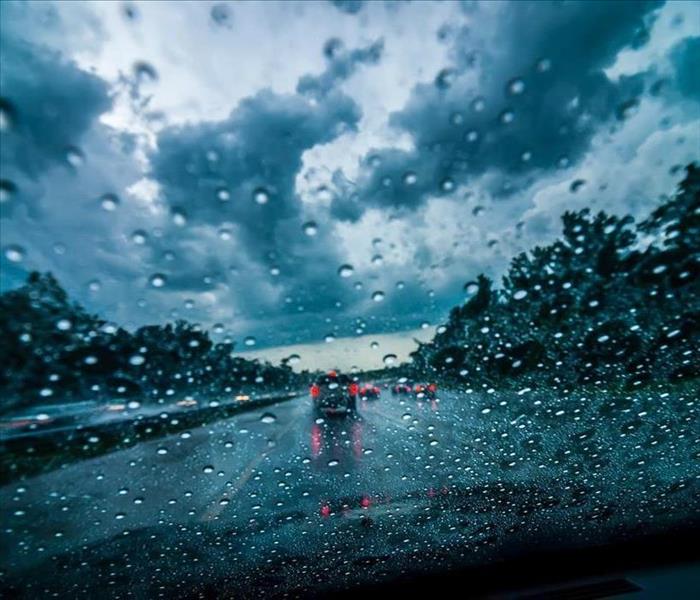 Sewer Backup may be more prevalent during heavy rains because of the overflow of water and sewer lines.
Sewer Backup may be more prevalent during heavy rains because of the overflow of water and sewer lines.
Nothing more gets you deeper into the Monday Blues like a gray sky and black puffy clouds looming over you. Add some crazy winds and a few branches flying across your car while you are driving to work and you are almost certain it’s going to be bad Monday. As work gets busy the superstition starts to fade away and now it seems like it’s going to be just a regular ol’ Monday, Right? WRONG. You go home and as you open your front door to your house, the foulest smell just punches you straight in the nose. It hurts so much you can’t help but start to tear…
Find out your Finished Basement is bubbling with Filthy water.
Back-up sewers are a nightmare for homeowners and renters. Not many are prepared for such a disaster. This week, as eastern Iowa received some severe thunderstorms and rain, many of our community members were affected by back-up sewer. Basements are in danger of getting wet with BLACK WATER possibly due to the home’s clogged pipes or maybe an overflow of the city’s pipelines or main sanitary system. Either way, it’s a disheartening situation especially if your basement is finished.
What to do if you have Sewer Backup.
- DO NOT TOUCH THE WATER. Keep your children and pets away from the dirty water. Black Water is extremely dangerous. It is unsanitary and can cause severe illness and possibly death if ingested.
- CALL A RESTORATION COMPANY. A sewer back up is an emergency and needs to be dealt with immediately. We (SERVPRO) can help in such a disaster and we have 24/7 Emergency Services available.
- CALL YOUR INSURANCE COMPANY. Cleaning up after a sewage backup can be costly. Call your insurance agent TODAY and find out if your sewer lines are covered.
Prevent a sewer backup by regular inspection and maintenance on your pipes.
The City of Waverly recently sent out a mailing brochure to their community about not flushing F.R.O.G.s down the drains. This acronym stands for Fats, Rags, Oils, and Grease. Here’s a few more things not to put down your drains; coffee grounds, eggshells, wet wipes, feminine hygiene products, and diapers. The health of your drainage pipes can save you from sewer backup.
CALL US FOR WATER DAMAGE, FLOODING, OR SEWER BACKUP. WE ARE HERE TO HELP. 319.268.1521
Tips on how to avoid water damage from Kitchen Appliances
7/8/2019 (Permalink)
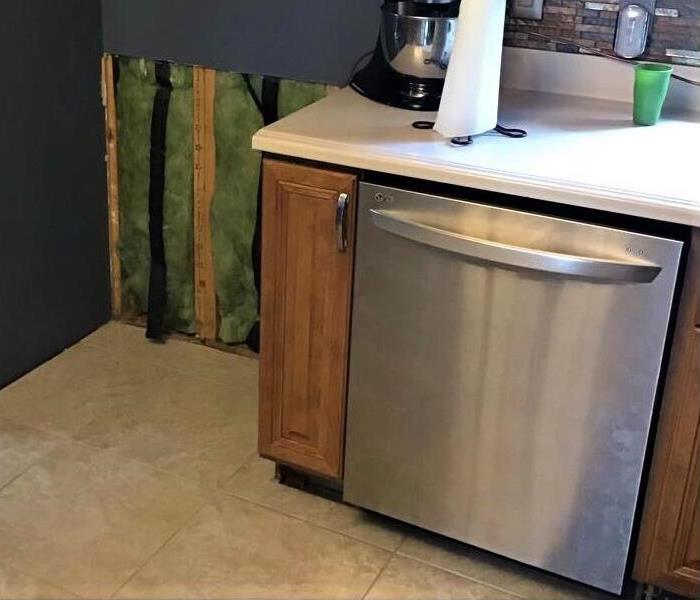 Fridge and dishwasher leaked water. The fridge was removed and the production crew made a flood cut to dry the walls and cabinets.
Fridge and dishwasher leaked water. The fridge was removed and the production crew made a flood cut to dry the walls and cabinets.
Did you wake up to find your kitchen flooded by an appliance?? Call us at (319) 268-1521.
Most of us think nothing of turning on the dishwasher before bed or as we leave for work, but malfunction or lack of maintenance on appliances can cause severe water damage if unnoticed for a long period of time. We have a few maintenance tips to avoid such a problem.
Top Kitchen Appliances that can cause Water Damage are…
- Dishwasher
- Refrigerator Water and Ice Dispenser
Dishwasher Tips and How to Clean the Filter.
- The dishwashers water line can slowly deteriorate over the years. Check your water line connection regularly.
- If you see a puddle of water near the dishwasher every time you run it, turn off the water valve to your dishwasher is connected to and call a plumber. The plumber will help you determine the issue. Besides a worn-out water line, issues may result from old gaskets, door issue, and a clogged drain.
- Wipe your filter with a paper towel to remove all the gunk. Then run it under warm water or dip it in vinegar for a few hours. *
Refrigerator Ice Maker Tips and How to Clean it.
- Avoid moving the refrigerator so as not to misalign the copper tubing that supplies the water to the fridge.
- If it is leaking, turn off the water valve and call your plumber or an appliance expert.
- To clean your dispenser, turn off the water valve and unscrew the copper tubing. Pour vinegar into the tube letting it run downward. Throw away the ice. Connect the copper tubing. Throw away the first batch of ice cubes. Run the water dispenser until all vinegar has run through. Scrub the outside of the dispenser with a small brush that’s been dipped in vinegar.*
- To extend the life of your water filter, Take the filter and wipe off large particles with a paper towel. Soak the filter in warm water with vinegar. Rinse under running water until it runs clean. Let it air dry. *
*All appliances are different so please check your manual or call an appliance expert to clean out your appliance.
If you are experiencing some water damage, click here for some tips on what you can do until help arrives.
Water Spigot leaks into Split Level Home
6/17/2019 (Permalink)
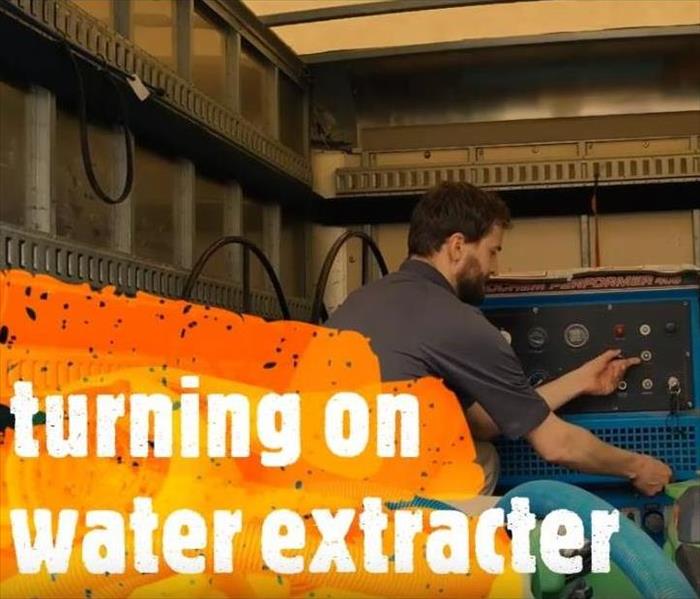 Technician Work on Water Damage from Spigot Leak
Technician Work on Water Damage from Spigot Leak
The Phone Call
The last day of the week, SERVPRO of Black Hawk County got a call for a water damage job. The call was received in the office where our CEO Scott Demuth took down the name, address, and telephone number. He then called Evan, a production manager who was already out in the field, to go to the house to inspect the situation and set a plan of action on how to remove the water. Before Evan arrived at the customer’s home, Evan called the customer to introduce himself and give him an estimated time of arrival. The customer was running an errand so there was a quick coffee stop at our local cafe Sidecar.
The Arrival
After, Evan drove up to a nice neighborhood with newer homes. Evan parked his truck and brought in an iPad, a small black case that held a handheld moisture meter and a thermal hydrometer, and a moisture meter gun or a Hydrosensor. The customer just arrived and was waiting on the front porch. The customer led Evan inside the house. Gary (the customer) started entering the house as he started to talk about the situation in the lower level of his home but was interrupted by the barking of a small, cute dog. The customer warned Evan that his dog isn’t very friendly with strangers but Evan is not scared of no cute dog. He proceeded to introduce himself to Gary (the customer) and went to great details of what he will be doing there.
The Intro
“Hi Gary, I’m Evan, a production manager from SERVPRO. We just spoke a moment ago. I heard you have a water situation in the basement caused possibly by a water spigot. I’m going to go over what to expect by my visit. I will inspect the damage and then after that, I have a few documents that I will need you to sign before we can get started with our services. I have a production team on their way with the equipment so they should be here shortly. Can you show me the location of the water damage?”
The Situation
Gary lead Evan downstairs to a walkout basement. They walked towards a corner by sliding doors leading to the backyard. There was a wall that connected two rooms. On the other side of the room was a guest bedroom. The water seems to have stemmed from that corner. Gary let us know that there’s a spigot outside that seems to be right in between this wall. Gary and his wife had recently started using the spigot to water their outside plants. The other day, his wife went down to the lower level to work on a craft project when she felt the squish of the water by the table near that corner. Gary let us know that there will be a plumber to check it on Monday. Evan took out his handy dandy Hydrosensor and started poking it to the carpet. It beeped loudly, letting Evan know that it was definitely wet. He then walked further from the corner until the beeping didn’t occur to determine how far the affected area was. He then went to the guest bedroom and repeated the same thing. Luckily, the affected area wasn’t too large. He then pulled up the carpet from the corner and noticed a small growth of mold spores. The carpet pad that lay underneath the carpet had a moisture barrier on the top but it did little to prevent the water that came from below.
The Plan
Evan told him that we will start by extracting any water from the carpet and carpet pad. Then, we will cut out the affected carpet pad which can later be replaced. Then, we will spray the carpet and floors with an antibacterial to prevent odor-causing bacteria. The team will also cut out about 15” of drywall which is referred to as a flood cut. This will allow easy access to the spigot for the plumbers and to avoid further growth of bacteria caused by moisture. We will then pull out the affected baseboard and tack strip that have been warped by the moisture. After, we will set up a dehumidifier and air dryers that are strategically placed to dry up the moisture.
The Documents
Evan then read through documents that needed to be signed before the plan can be started. He thoroughly read each document, clarifying any concerns or questions that Gary had. These documents include an Authorization to Perform and Direction of Payment Form, Customer Information Form, and Customer Equipment Responsibility Form. This took only about 10-12 minutes to complete. During that time, Chris our technician arrived with the truck.
Plan into Action
Our other technicians were held back at other jobs but Evan was able to help Chris get the process started. The team did everything as planned while Gary took a break upstairs with the confidence and trust that SERVPRO will make it “Like it never even happened.”
CALL US AT (319) 268-1521
If you have water damage caused by a leak, be confident that we will be there as soon as we can to prevent further damage and help restore your home. Water damage that is left ignored may cause further problems to your home. We have a hard-working team that gets the job done so you won’t have to!
Things to Keep in Mind When Buying a Home
3/24/2019 (Permalink)
 It pays to take your time and do your research when making big purchases.
It pays to take your time and do your research when making big purchases.
Buying a home is no small purchase. In fact, most people spend 20 years paying off their home. That’s why we want you to be well-informed as you make a decision of a lifetime.
Beware of Flood Zones
The first item you should focus on is location. Is the home in a flood zone? Are there any bodies of water nearby that could threaten your home? Particularly, if you’re moving to a new area, it’s even more important to do your own research on the area to ensure you’re aware of any potential problems.
Look for Water-Related Problems
Next, you should be aware of the ground the home sits on. Will water go toward the house or away? The answer should always be away. Be particularly cautious if the home is located at the bottom of a hill. The last thing you want is for your investment to become a money pit as soon as it starts raining. Landscaping can a quick fix in some cases, but not always.
Get a Second Opinion from an Expert
We highly recommend hiring a home inspector to give you closure that the home is structurally sound and won’t give you problems. The most expensive thing to renovate in a home is everything behind the walls (bathrooms and kitchens are the worst cost-wise). So even if the floors have been redone and the cabinets have been replaced, don’t be too quick in making a decision.
What You Need to Know About Sewer Backup Coverage
2/18/2019 (Permalink)
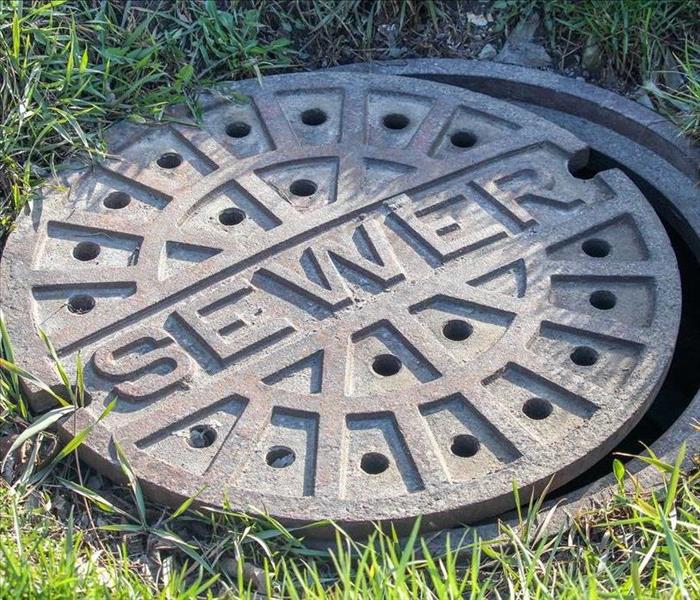 Be your own advocate and ask your agent about your sewer backup coverage today.
Be your own advocate and ask your agent about your sewer backup coverage today.
Insurance can be a tricky concept to understand. There’s just so much to know that it’s no surprise that we miss details here and there. One detail we want you to be aware of is your policy regarding sewer backup. Every insurance policy is different in this matter, and we strongly recommend consulting with your agent to ensure you are covered.
It's Becoming More Common
Sewer backup happens all too often when it’s least expected. In fact, sewer backups are increasing at an annual rate of 3%. That’s an alarming percentage because it’s happening in homes that haven’t encountered it for 30 plus years, and it’s also happening in homes that are fairly new. The fact is no discrimination is involved when life decides to throw something unexpected your way.
Protect Your Home
One way you can protect your home is to add a sewer backup endorsement to your policy. It’ll only cost you $40 to $250 annually depending on your home and location, and it covers thousands of dollars more than the included coverage. Please note this is different from water backup coverage.
It is Your Responsibility
According to Insurance Information Institute, “Most homeowners may not realize that they are responsible for the maintenance and repair of their house or sewer lateral—that is, the pipeline between the city sanitary sewer main (which is usually located in the street) and the building.”
Causes of Increased Sewer Backups:
- Aging sewer lines
- Combined pipelines
- Tree roots
- Sanitary main blockages
Let's Talk Cost
A typical sewer backup can cost anywhere from $500 to over $5,000 in repairs and cleaning. It is heavily dependent on whether or not the sewer backup occurs in a finished basement or not.
Start the Conversation
We hope this information encourages you to spark up a conversation with your agent because it’s easily overlooked. Even one of our employees found out she didn’t have coverage when she joined our team, but now she’s all set with the additional coverage.
Additional Sources: https://budgeting.thenest.com/
Ultrasonic Cleaner to the Rescue
1/10/2019 (Permalink)
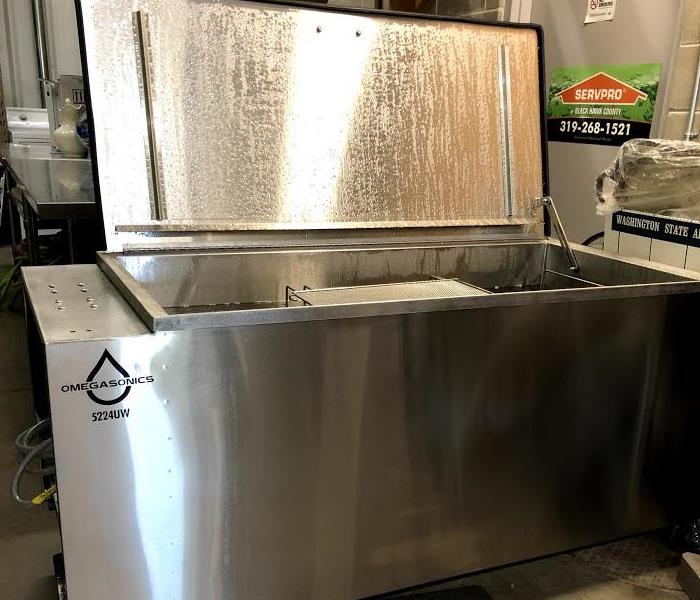 The Ultrasonic Cleaner is like no other piece of equipment.
The Ultrasonic Cleaner is like no other piece of equipment.
Our brand-new toy—I mean equipment—keeps impressing us even after the holidays. The Ultrasonic Cleaner is a unique machine that is used to restore fire and water damaged items.
With the help of sound waves, the Ultrasonic Cleaner is able to create millions of tiny vapor bubbles that instantaneously implode. This collection of energy is then able to produce the tremendous energy needed for the most efficient cleaning process. The time-saving capabilities have been jaw-dropping.
Without the owner’s manual, we’d probably bypass the science behind the entire process altogether and settle for the simpler explanation: it’s magic.
If you want to truly be impressed, take a peek at all of the items this machine can restore:
- Electronics – televisions, VCR, DVD, telephones
- Antiques – silver, crystal, metals, finished wood, ceramics
- Specialty – delicate or intricate objects
- Kitchen Appliances – coffee machines, toasters, food processors
- Computer – monitors, keyboards, CPU’s, printers
When you find yourself in a disaster, don’t be quick to throw away your belongings. Odds are, we can bring them back to their previous state. Give us a call at (319) 268-1521.
Drying water out behind items with the Injectidry System.
9/19/2018 (Permalink)
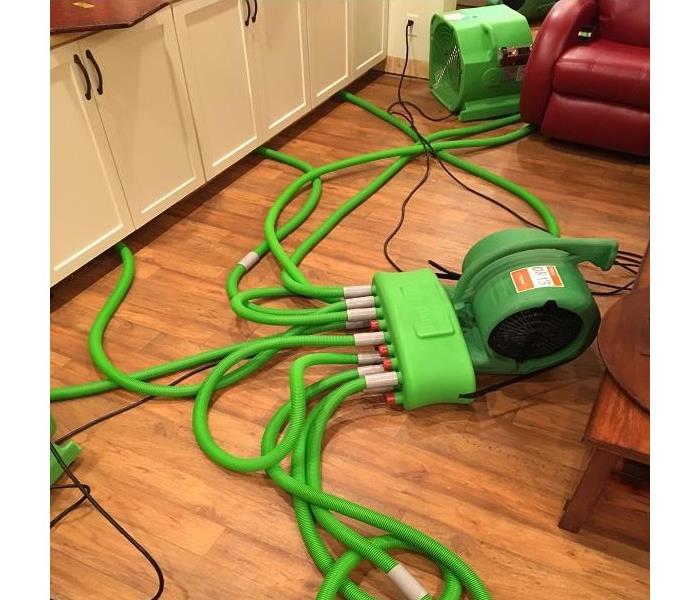 Drying out behind wet cabinets after a rainstorm.
Drying out behind wet cabinets after a rainstorm.
Time is of the essence when drying out the areas you can’t see or easily get to after a heavy rain storm floods a basement in Waterloo, Iowa. When water gets and sits behind cabinets it creates the perfect conditions for fungi to grow as well as deterioration of wood materials!
The Injectidry system is the way to disperse and circulate air BEHIND things to dry it out. It utilizes a regular air mover by attaching the large “lego look-alike” piece to the front and adding as many hoses as necessary to spread the air around. The hoses focus the air to specific cavities that are wet. SERVPRO of Black Hawk County drilled holes in the kickplate area of the cabinets to permit the hoses to be positioned for directional air distribution.
The finished basement was restored by the use of the Injectidry system instead of demolished due to hidden water.
New Skills to Better Serve YOU
7/23/2018 (Permalink)
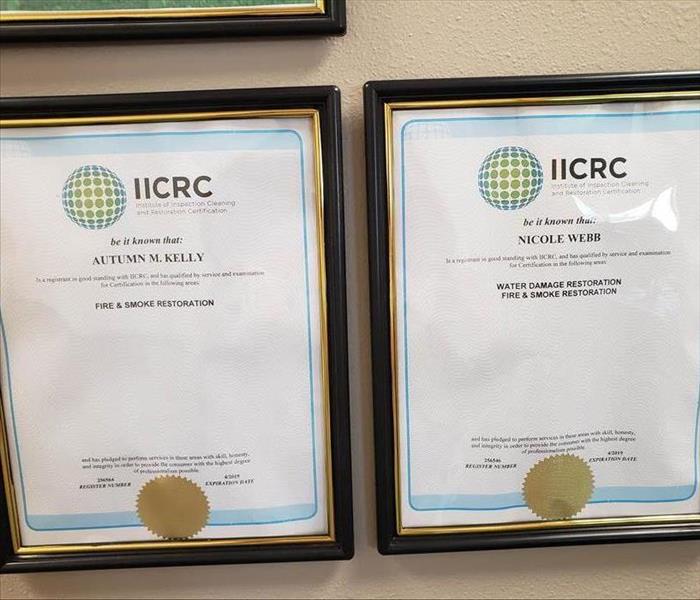 Here are some of the many certificates received by our versatile technicians.
Here are some of the many certificates received by our versatile technicians.
We are proud to share that some of our technicians have undergone training recently and are now certified in new areas!
Water Damage Restoration Technician (WRT)
Jake Barkow, Devon Burgess, and Nicole Webb received certificates as Water Damage Restoration Technicians (WRT). The training was a 3-day process where they took the time to learn how to handle different losses.
For instance, in a water loss, they first have to determine what category the water belongs to. The different categories indicate the level of contamination the water has been exposed to.
- Category 1 – Water comes from a clean source and does not pose a substantial risk from dermal, ingestion, or inhalation exposure.
- Category 2 – Water contains significant contamination and has the potential to cause discomfort or sickness if contacted or consumed by humans.
- Category 3 – Water is grossly contaminated and can contain pathogenic, toxigenic, or other harmful agents.
Crazy right? Who would’ve thought there were different categories for water.
Fire and Smoke Restoration Technician (FSRT)
Brett Armfield, Lana Bruhn, Autumn Kelly, and Nicole Webb all received a certificate as a Fire and Smoke Restoration Technician (FSRT). Extra snaps and claps go to Nicole for doing both certifications back-to-back!
Once a technician receives additional training, they are now more versatile and able to take on more responsibilities and leadership roles. For example, our current Project Managers started out as technicians and kept receiving training. With time and mentoring, they both landed leadership roles at SERVPRO in Black Hawk County.
Things to do Before You Leave for Vacation
7/10/2018 (Permalink)
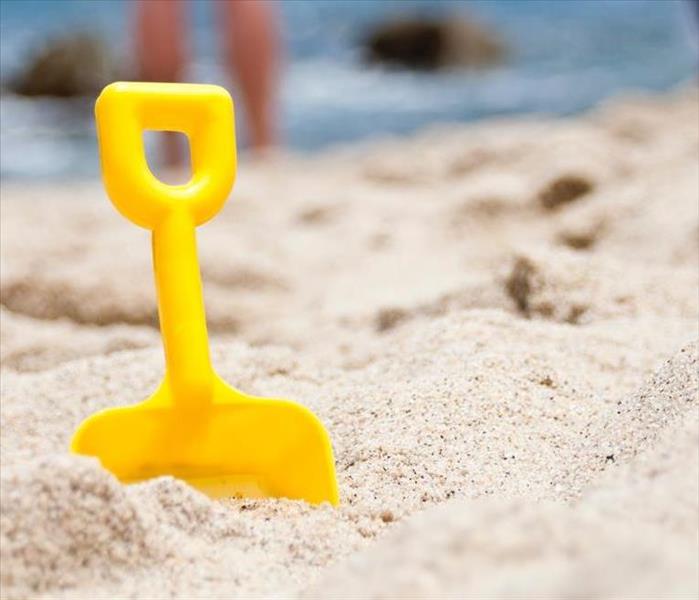 Rest easy soaking up the sun on a beach and know your house is a little safer while you're away.
Rest easy soaking up the sun on a beach and know your house is a little safer while you're away.
Let’s be honest, a lot of terrible things can happen to your home, and you have 100% no control over it. A pipe bursts. A heavy rain comes. Whatever it may be, you are not in control.
There is also a small list of things you DO have control over, and you should take advantage of it before leaving for vacation this year. Follow these steps and rest easy while soaking up the sun on a beach.
1. Turn off the main water supply.
Now, why would you want to do that? Well, if we’re thinking of the worst-case scenario, you’ll probably have a leaking supply line the minute you step out the door for your week-long vacation. Greaaaat. Just what you wanted. But wait. If you shut off the water supply, the amount of water leaking is significantly lower. Best of all, it only takes a few minutes to do.
2. Check the sump pump.
Another scary thought is sump pump failure. That’s why you should check it before departing. Try dumping a bucket of water in and wait. Your sump pump should turn on and everything should be hunky dory. But if it doesn’t turn on, that’s a red flag.
3. Unplug Electronics.
Just do yourself a favor and unplug everything that isn’t plugged into a surge protector—as long as it’s switched off. Even then, unplug the surge protector if you want to be extra careful with unexpected power surges. You’ll also save money by doing this, so that’s neat.
4. Don’t turn your air off completely.
As tempting as it may be to save some money by turning off your air while away, try to resist. The reason you want to keep your air on is that your home needs air circulation; otherwise, heat can build up and effect wood floors and other surfaces alike. Setting your thermostat to 85 degrees will keep your electronics cool and will save you money too. You’re basically preventing your house from becoming a giant oven.
5. Check your gutters.
Downspouts should release water at least 10 ft. away from your house. If this is not the case for you, maybe an extension is in order.
6. Have a trusted friend check on your house, even if you don’t have any pets.
Nothing beats having a human being keep an eye on your home while away. Feel free to give specific instructions like, “Go check our basement to make sure there is no water in the furnace room.” They’ll care as much as you care, so be clear as to what you’re concerned about.
Keeping your home safe is our top priority, so please, take precautions before leaving for vacay and have a wonderful time.
Sources:
https://www.familyhandyman.com/
https://www.popularmechanics.com/
Water Extraction versus Evaporation
2/21/2018 (Permalink)
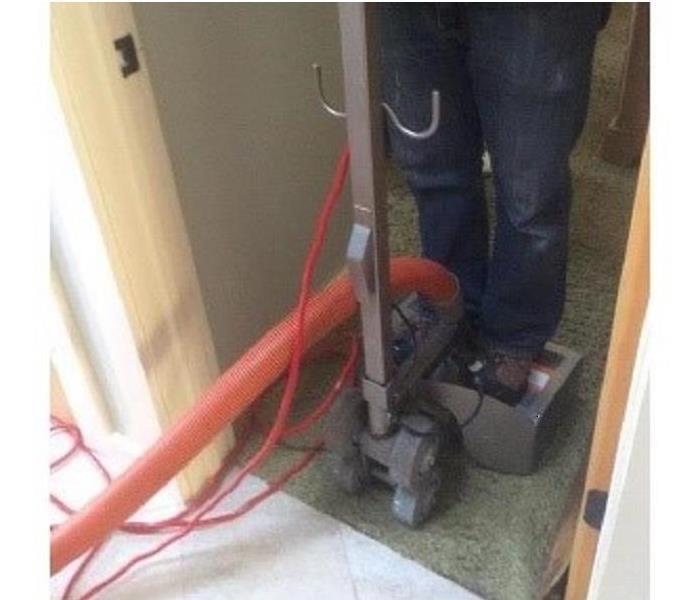 Weighted extraction "Ride On"
Weighted extraction "Ride On"
There are two ways that excess water can be removed from your property after a water damage loss, Extraction and Evaporation. A much larger volume of water can be removed by extraction in a much shorter period of time.
It is a pretty simply process to test, pour a few ounces of water on the counter top in two different areas. Set up a fan blowing across one area to utilize air movement to speed up evaporation. Use a sponge or dry cloth on the other area. Needless to say, this will prove the point. The same is true during a water damage loss to your home or business.
At SERVPRO of Black Hawk County we utilize both methods to get your property dried up as quickly as possible.
For extraction, we use several pieces of equipment including hard floor wands and carpet extraction machines, including this "ride on" weighted model pictured. Strong suction and downward pressure allows us to get water out of carpet and pad. This process is the most effective on free or surface water.
Once the water has been soaked into other materials such as, hardwood floors, drywall or wood, extraction becomes less effective and we concentrate on evaporation.
Evaporation uses a combination of air movement, dehumidification and sometimes heat to remove water that is bound or soaked into hard to dry materials.
Whether you have excessive surface water immediately after a storm or other water event or you have water that has become bound in building materials, SERVPRO of Black Hawk County has the tools and knowledge to make it "Like it never even happened."
Content and picture provided by SERVPRO of Dubuque, 2017.
Freeze Drying can save your valuable documents and important papers when they have been damaged by water!
2/21/2018 (Permalink)
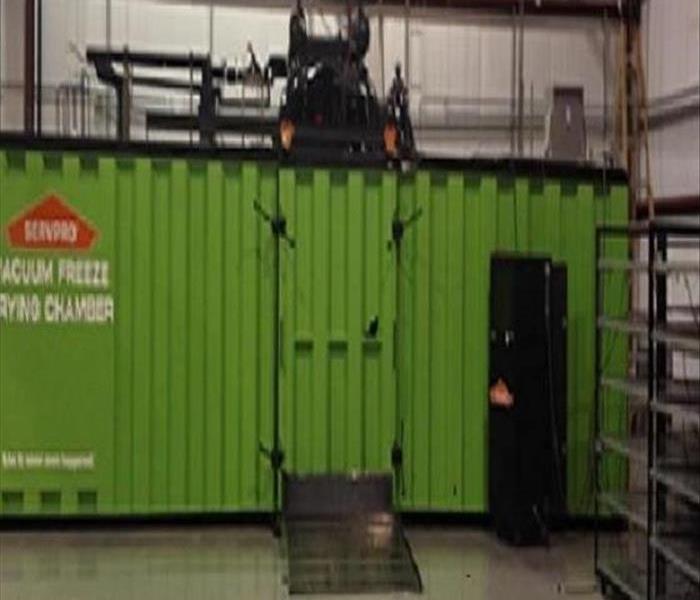 SERVPRO'S Large Scale Vacuum Freeze Drying Document Chamber.
SERVPRO'S Large Scale Vacuum Freeze Drying Document Chamber.
SERVPRO Strong! That’s what I call our relationship with the rest of the SERVPRO franchises! We are unique in the fact that we all work together, sharing resources to better serve you!
One resource is large scale and portable document drying chambers. SERVPRO of Dubuque, Iowa offers a document restoration service. It’s true other restoration companies have this service, so what is the difference?
For starters, they have one of the only HIPAA certified document response crews in the area. If an event causes documents to get wet, response time is critical to stabilize the documents before they begin to degrade. Once the documents are frozen to stabilize them, we have plenty of time to discuss restoration options with the client.
The most effective method of restoration is vacuum freeze drying. The documents are brought under extreme vacuum to very low temperatures and sublimation will remove the moisture directly into a gas form.
SERVPRO of Dubuque has a large freeze drying chamber located in the Midwest, as well as access to one of the only mobile drying chambers in the country. The mobile unit can be delivered to a client’s building and the restoration can take place there. They are one of the only restoration companies that can accommodate this request.
Here is a list of items that can be salvaged using vacuum freeze drying:
- Books and manuscripts: coated papers, maps, parchment, pulp paper, drafting linens, text books, reference books, manuals
- Business/Personal records and documents: legal/bank/company files, patient and medical records, x-rays, engineering and architectural plans and drawings, catalogues, reference materials, certificates, contracts, passports, transcripts, tax records
- Historical and collectible items: archival documents, rare documents, maps, stamp collections, money collections
- Keepsakes: photographs, leather and hide items, newspaper articles, recipe books, cards, scrapbooks, baby books, wedding albums, yearbooks, baskets, awards & achievements
- Textiles: embroidery and needlework, silks, tapestries, flags
- Artwork: acrylic paintings, linen drawings, water colors.
SERVPRO of Black Hawk County utilizes these services. From a single file cabinet filled with personal financial documents to a warehouse full of documents, it can all be handled.
When you have SERVPRO of Black Hawk County cleaning and restoring your home or business, you will have a multitude of resources available to you! That’s the SERVPRO strong way!
Content provided by SERVPRO of Dubuque, 2017.
Its The Water You Don't See That Causes The Most Damage! SERVPRO of Black Hawk County is available 24/7 for your water damage issues.
5/2/2017 (Permalink)
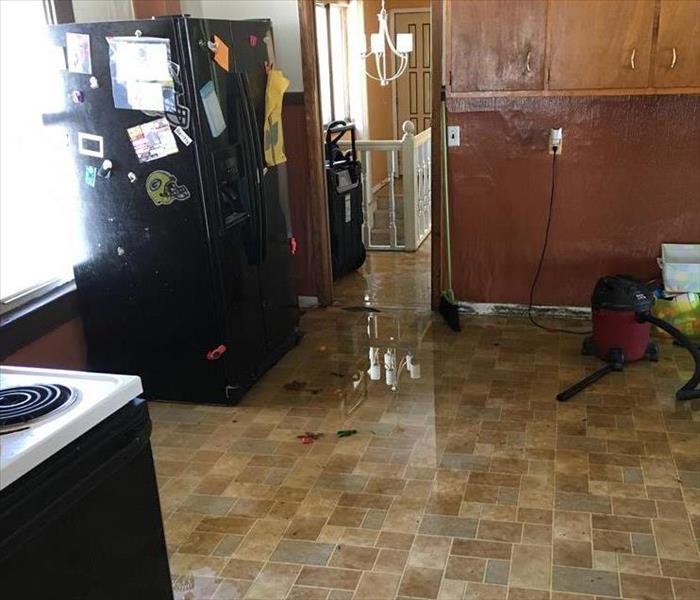 Standing water in the kitchen and flowing into the living area after a broken pipe flooded this home.
Standing water in the kitchen and flowing into the living area after a broken pipe flooded this home.
Flooding and water emergencies don’t wait for regular business hours and neither do we. SERVPRO of Black Hawk County provides emergency cleaning and restoration services 24 hours a day, 7 days a week—including all holidays.
Faster To Any Size Disaster
Flooding and water damage is very invasive. Water quickly spreads throughout your home and gets absorbed into floors, walls, furniture, and more. SERVPRO of Black Hawk County arrives quickly and starts the water extraction process almost immediately. This immediate response helps to minimize the damage and the cleaning and restoration costs.
Need Emergency Service? Call Us 24/7 – SERVPRO OF Black Hawk County
Water Damage Timeline
Within Minutes
- Water quickly spreads throughout your property, saturating everything in its path.
- Water is absorbed into walls, floors, upholstery, and belongings.
- Furniture finishes may bleed, causing permanent staining on carpets.
- Photographs, books, and other paper goods start to swell and warp.
Hours 1 - 24:
- Drywall begins to swell and break down.
- Metal surfaces begin to tarnish.
- Furniture begins to swell and crack.
- Dyes and inks from cloth and paper goods spread and stain.
- A musty odor appears.
48 Hours to 1 Week:
- Mold and mildew may grow and spread.
- Doors, windows, and studs swell and warp.
- Metal begins to rust and corrode.
- Furniture warps and shows signs of mold.
- Paint begins to blister.
- Wood flooring swells and warps.
- Serious biohazard contamination is possible.
More Than 1 Week:
- Restoration time and cost increase dramatically; replacing contaminated materials and structural rebuilding may be extensive.
- Structural safety, mold growth, and biohazard contaminants pose serious risks to occupants.
About SERVPRO of Black Hawk County
SERVPRO of Black Hawk County specializes in the cleanup and restoration of residential and commercial property after a fire, smoke or water damage event. Our staff is highly trained in property damage restoration. From initial and ongoing training at SERVPRO’s corporate training facility to regular IICRC-industry certification, rest assured our staff is equipped with the knowledge to restore your property.
 Targeted Drying in Action: SERVPRO's equipment hard at work restoring a water-damaged bathroom and preventing further damage.
Targeted Drying in Action: SERVPRO's equipment hard at work restoring a water-damaged bathroom and preventing further damage.





 24/7 Emergency Service
24/7 Emergency Service






























